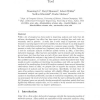Free Online Productivity Tools
i2Speak
i2Symbol
i2OCR
iTex2Img
iWeb2Print
iWeb2Shot
i2Type
iPdf2Split
iPdf2Merge
i2Bopomofo
i2Arabic
i2Style
i2Image
i2PDF
iLatex2Rtf
Sci2ools
ENTCS
2006
2006
Analyzing the Uses of a Software Modeling Tool
While a lot of progress has been made in improving analyses and tools that aid software development, less effort has been spent on studying how such tools are commonly used in practice. A study into a tool's usage is important not only because it can help improve the tool's usability but also because it can help improve the tool's underlying analysis technology in a common usage scenario. This paper presents a study that explores how (beginner) users work with the Alloy Analyzer, a tool for automatic analysis of software models written in Alloy, a first-order, declarative language. Alloy has been successfully used in research and teaching for several years, but there has been no study of how users interact with the analyzer. We have modified the analyzer to log (some of) its interactions with the user. Using this modified analyzer, 11 students in two graduate classes formulated their Alloy models to solve a problem set (involving two problems, each with one model). Our ...
Alloy | Analysis | Analyzer | ENTCS 2006 |
| Added | 12 Dec 2010 |
| Updated | 12 Dec 2010 |
| Type | Journal |
| Year | 2006 |
| Where | ENTCS |
| Authors | Xiaoming Li, Daryl Shannon, Jabari Walker, Sarfraz Khurshid, Darko Marinov |
Comments (0)

